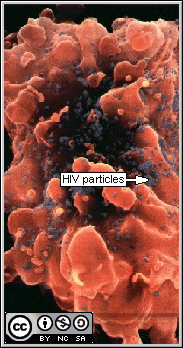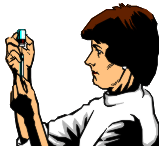 |
|||||||||||
| Module 5: HIV/AIDS Issues: An Approach To Managing The Epidemic - Introduction |
OBJECTIVES |
By the end of this module, you should:
|
This presentation is an illustration of the type of information which is presented to line managers.
INTRODUCTION: BIOLOGY OF HIV/AIDS:
The HIV virus:
T-Helper cells:
 |
T-helper cells are regulators and control the immune system. Their functions are to
The picture on the left shows a T4-helper cell being attacked by HIV particles. Killing T-helper cells is the equivalent of knocking out the central command of an army. |
How does HIV work?
The mechanism of action of the HIV virus may be summarised in the diagram below:
The disease process:
At first, relatively few new viruses are produced and little damage is done. Billions of T-helper cells are present.
After 3 -7 years however, huge amounts of viral particles are circulating and infecting cells. A large number of the immune cells are destroyed and this leads to the reduction in the person's immunity.
In turn, this leads to:
- metabolic changes
- other organisms which are harmless in healthy individuals causing disease and death. These are known as opportunistic infections.
- cancer.
Transmission issues:
HIV is found in varying concentrations or amounts in blood, semen, vaginal fluid, breast milk, saliva, and tears.
HIV has not been found in sweat.
 |
Something to think about...: What does this mean to your organisation? |
Therefore routine work, including food handling is not an issue (unless you own a brothel!!)
Treatment:
 Treatment consists in attempting to counter the rising probability of infection as the body's defence system breaks down, interventions are designed to:
Treatment consists in attempting to counter the rising probability of infection as the body's defence system breaks down, interventions are designed to:
- boost the immune system;
- prevent opportunistic infections such as TB;
- prevent the virus from replicating;
- Complex issues need to be managed:
- medical
- emotional
- social
- financial
REFERENCES:

Postgraduate Diploma in Occupational Health (DOH) - Modules 3 – 5: Occupational Medicine & Toxicology by Prof Rodney Ehrlich & Prof Mohamed Jeebhay is licensed under a Creative Commons Attribution-NonCommercial-ShareAlike 3.0 Unported License.
Permissions beyond the scope of this license may be available at http://www.healthedu.uct.ac.za/
